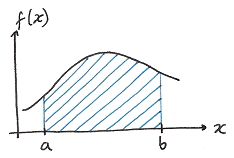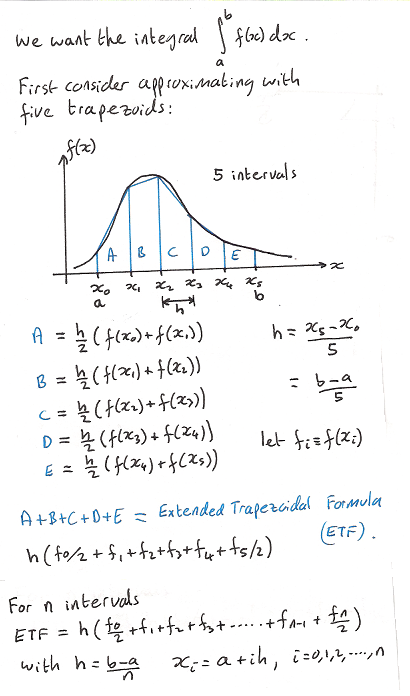Complete: ##################-- (90%)
Integration of a function f(x) |
1. The Extended Trapezoidal Formula (ETF) 2. The Extended Simpson's Formula (ESF) |
The integral of a function f(x) between the limits a and b is simply the area under the curve between a and b. Finding the integral analytically may be difficult and so a numerical solution may be necessary or simply convenient. The following sections describe two methods of numerical integration, they are the most simple cases of the Newton-Cotes formulas which are a group of formulas based on evaluating the integrand at n+1 equally-spaced points.

The ETF is implementated in the program below.
nmprimer-ETF.cpp: Extended Trapezoidal Formula for the integral of a function.
1: 2: 3: 4: 5: 6: 7: 8: 9: 10: 11: 12: 13: 14: 15: 16: 17: 18: 19: 20: 21: 22: 23: 24: 25: 26: 27: |
// Numerical integration via the Extended Trapezoidal Formula (ETF)
#include <cmath>
#include <iostream>
using namespace std;
double f(double x) {
double y = 1.76 + 3.21*x*x;
return 894.*x / (y*y*y);
}
int main() {
const int n=100;
const double a=0.0, b=1.61;
const double h = (b-a)/n;
double etf = (f(a)+f(b))/2;
for (int i=1; i<n; i++)
etf += f(a+i*h);
etf *= h;
cout.precision(9);
cout << "The integral = " << etf << endl;
} |
The integral = 21.7886724 |
2. The Extended Simpson's Formula (ESF)
In the Extended Simspson Formula (ESF) trapezoids are replaced by the quadratic polynomials; the truncation error in the ESF is proportional to 1/n4 and so we should expect results with much greater accuracy compared to the ETF.
The ESF is implementated in the program below to solve the same problem as the above ETF program.
nmprimer-ESF.cpp: Extended Simpson's Formula for the integral of a function.
1: 2: 3: 4: 5: 6: 7: 8: 9: 10: 11: 12: 13: 14: 15: 16: 17: 18: 19: 20: 21: 22: 23: 24: 25: 26: 27: |
// Numerical integration via the Extended Simpson's Formula (ESF)
#include <cmath>
#include <iostream>
using namespace std;
double f(double x) {
double y = 1.76 + 3.21*x*x;
return 894.*x / (y*y*y);
}
int main() {
const int n=100;
const double a=0.0, b=1.61;
const double h = (b-a)/n;
double esf = f(a)+f(b);
for (int i=1; i<=n-1; i++)
esf += 2.0 * pow(2.0,double(i%2)) * f(a+i*h);
esf *= h/3;
cout.precision(9);
cout << "The integral = " << esf << endl;
} |
The integral = 21.7922915 |
The choice of the value of n in both the ETF and ESF may require some experimentation. Observing the difference between a solution evaluated with n intervals and a solution evaluated with 2n intervals is usually a reasonable estimate of the error in the evaluation with n intervals. Using this idea one can modify the above programs to evaluate the integral with increasing number of intervals until a predetermined tolerance is reached. This is left to the reader as an exercise.
Complete: ##################-- (90%)